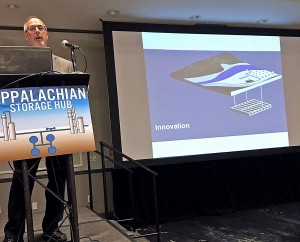From an Article by Rick Shrum, Washington PA Observer-Reporter, June 7, 2017
Rick DeCesar, accompanied by a rendering of a storage facility, spoke Thursday at the Appalachian Storage Hub Conference. There was a lot of salty talk at the Hilton Garden Inn at Southpointe.
Natural gas liquids storage was the focal point of the third annual Appalachian Storage Hub Conference. The proposed hub, focused in the Ohio River Valley, is a $10 billion infrastructure project that would provide a midstream hydrocarbon storage system. It is related to the oil and gas industry.
Raw-material hydrocarbons such as ethane and butane would be placed separately in underground salt or hard rock caverns – 6,000 feet down. Many of the energy and chemical professionals who were on hand, to speak or to observe, seemed to have a preference.
“Salt is best,” one corporate official said from the audience.
“Ethane is not stored in any hard rock caverns today,” said another.
A storage hub feeds ethane to cracker plants, such as the $6 billion facility that Shell is building in Potter Township, Beaver County. The plant “cracks” ethane molecules into petrochemical building blocks that can be refined to create polyethylene, a plastic used for various purposes.
Salt cavern storage, according to the website storengy: “involves a series of caverns leached out of the deep, thick layers of rock salt. The caverns are created by injecting water to dissolve the salt, which is then extracted in the form of brine. There is then room for natural gas, which is injected and stored in gaseous form at high pressure.
“Impermeable and non-porous, these caverns are remarkably waterproof.”
The six-hour session played out before a decidedly pro-industry crowd, and also featured talk about other cracker plant projects being considered across the tri-state, along with pipelines, different energy sources and opportunity zones.
Joe Barone, president of Shale Directories, and Tom Gellrich, chief executive officer of TopLine Analytics, organized the event. Barone’s website, ShaleDirectories.com, connects the oil and gas industry with local businesses. Gellrich’s firm consults with the energy industry on downstream impacts of shale gas.
Gellrich kicked off the program with a list of industry-related predictions for the next 10 years. Among the highlights: the PTTGC ethane cracker, on the verge of approval for Dilles Bottom in Belmont County, Ohio, will get the go-ahead this year; that Shell, out of space, will announce plans to expand the Beaver County cracker in 2023 and again in 2028; and that in 2030, U.S. News & World Report will include the region on its list of the Top 10 Places to Work.
Jason Stechschulte, business development manager for MPLX LP, a partner with MarkWest Energy, touted a full portfolio of energy sources. “All forms are needed and fossil fuels will continue to be the lion’s share,” he said. “Fossil fuels make our lives easier.”
Rick DeCesar, a Washington County resident for 15 years, was part of a panel discussion during the morning session. He is vice president of pipeline and midstream services at AECOM in Pittsburgh, and said his firm has been a maintenance provider for the Beaver cracker since the beginning. DeCesar said 15 to 20 percent of the Falcon Pipeline, which will transport ethane to that plant, is in the ground.
Bryce Custer, of NAI Ohio River Corridor, spoke about opportunity zones, which he called “a great gift.” He said the basic concept of these zones “is forged in a fractured economy,” and that the purpose is to drive economic development in low-income areas.
Custer said there are 320 opportunity zones in Ohio, 300 in Pennsylvania and 55 in West Virginia. Using a map, he pinpointed several areas in the Ohio River Valley. Moundsville, according to Custer, is “a great area” for development. It is essentially across the river from the PTTGC proposed cracker.
Asked about potential environmental impacts of various energy endeavors, Custer replied: “I couldn’t say. The companies that are here are out to make a profit, but they want to do it right. If you can control environmental issues, this can be a major benefit.”
He closed by saying: “We are at the beginning of an economic revolution along the Ohio River corridor.”

